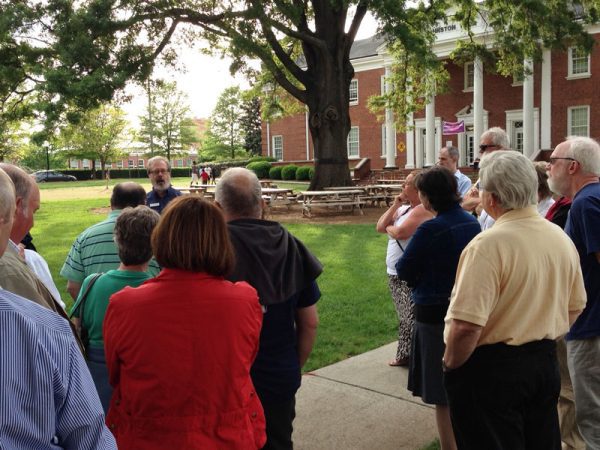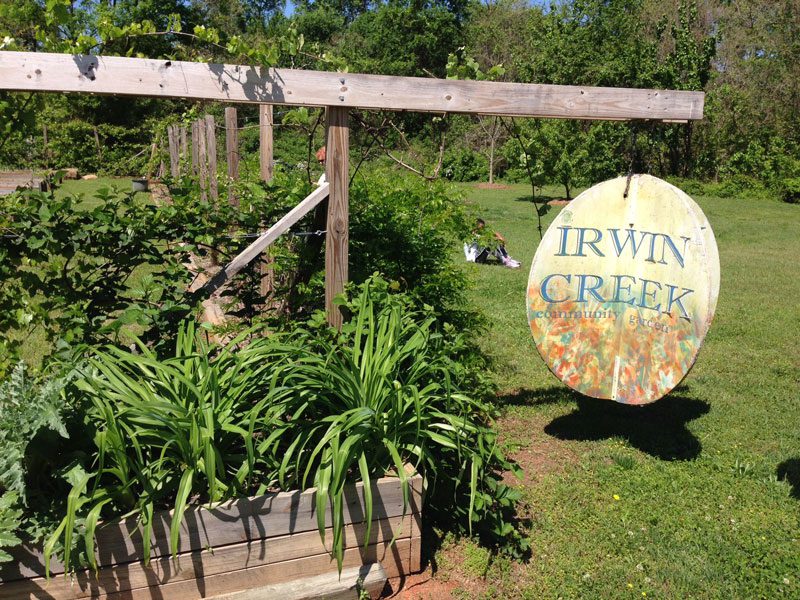Jane’s Walk: A weekend of discoveries

When we turned from Mayflower Road onto Hendren Avenue, it hit me. This Revolution Park neighborhood in west Charlotte was a dead ringer for the neighborhood in southeast Charlotte where I bought a tiny house when I first moved to town three decades ago. That neighborhood, Chantilly, built in the 1940s, has now gone upscale, its 800-square-foot cottages expanded or even demolished, as wealthier residents sought ever-more square footage.
|
Photo Gallery Scroll below for a photo gallery of the walks. |
After so many years in Charlotte it’s a treat to find an older neighborhood I’ve not explored before. This discovery took place Saturday morning, during one of six Jane’s Walks last weekend in Charlotte, sponsored by PlanCharlotte.org, the John S. and James L. Knight Foundation and in partnership with Jane’s Walk, an international organization based in Toronto.
The whole point of the walks – which honor legendary urban writer and activist Jane Jacobs – is to discover things in your own city that you might not have known. For me, Revolution Park was a discovery. The area was built, in part, by Osmond L. Barringer, Charlotte’s first automobile dealer, who also donated land for a park. When built, then-Bonnie Brae golf course (now Revolution Park golf course) was closed to black golfers, as was the swimming pool, Charlotte’s first public pool. After a lawsuit the course was desegregated in 1957; the pool in 1960. It was a predominantly white neighborhood until the era of urban renewal, when it became predominantly black. (Click here for an oral history project on Revolution Park by UNC Charlotte’s Public History program.) The park now is home to the Revolution Park Sports Academy in a stylish new building, complete with a fitness center that costs only $26 a month.
I began to wonder how long before these Chantilly-style houses are discovered by people looking for close-in locations and affordable, cozy houses – who can’t afford Wilmore or Wesley Heights. That’s the way Chantilly was discovered about 20 years ago, by people who were priced out of the Elizabeth and Plaza Midwood neighborhoods.
Another discovery for me came after I pitched in a bit at a cleanup along Little Sugar Creek in the Hidden Valley neighborhood. The cleanup, a project of North End Partners and the Hidden Valley Community Association, is part of a plan to create a nature walk alongside the creek between Martin Luther King Jr. Middle School and the Hidden Valley Ecological Garden.

The what? Who knew there was an ecological garden in Hidden Valley? Of course, plenty of people knew; I just wasn’t one of them. Until Saturday.
And it turns out I’ve been driving past it regularly, but because I’m driving and North Tryon Street is a multilane, busy road I had never looked over at Wellingford Street. There, at the corner is a 13-acre floodplain, wildlife habitat and stream restoration project created in 2004 by Charlotte-Mecklenburg Storm Water Services.
I made it to five of the six Jane’s Walks held last weekend in Charlotte.
Friday night’s Know NoDa walk was packed, with 35 people. Co-sponsored with the Charlotte Museum of History, the walk was the last of a series of neighborhood walks co-sponsored by the museum, Levine Museum of the New South and Historic Charlotte.* Led by Levine Museum historian Tom Hanchett, the walking group was a mix of newcomers to Charlotte, like Larry McCrank, who’s been in town a year after a career in Chicago, and longtime residents who had just never spent much time in the part of town formerly known as North Charlotte. One man recalled that the old Astor Theater on 36th Street, now the venerable Neighborhood Theatre music venue, used to be an X-rated movie house where high school kids could buy beer without a hassle.
Hanchett pointed to the historic landmark Hand Pharmacy building, now home to Cabo Fish Taco. He shared with the group that when he first moved to Charlotte, he was told, “We don’t have unions and there weren’t any strikes and we don’t talk about all that.” But, he later learned, the second floor of the building was a union hall. Charlotte workers meeting there helped plan the historic General Textile Strike of 1934, one of the largest strikes in U.S. history. (Wikipedia reports that observers at the time said 20,000 of 25,000 textile workers in Gaston County went on strike in early September 1934.)
Other walks throughout the weekend were in Enderly Park, through two parks in the Revolution Park and Clanton Park neighborhoods which are now connected by a greenway along Irwin Creek, visits to three ethnic eateries in east Charlotte with Hanchett again leading the group, and a walk Sunday along the Lynx light rail line in South End.
This was the third year PlanCharlotte has sponsored Jane’s Walks. Each year has brought discoveries, even for this journalist who has spent years visiting the city’s neighborhoods. As Jane Jacobs wrote in The Death and Life of Great American Cities: “Cities have the capability of providing something for everybody, only because, and only when, they are created by everybody.”

See more photos below.
* Updated May 6 to show other sponsors of the NoDa walk.
[view:slideshow1=block_1]